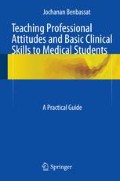Abstract
The interaction between two perceptive, calm persons of similar background generally does not pose undue problems. However, any dissimilarity between them, and any emotional distress of either, may interfere with communication. To help students overcome barriers to communication with patients, I had them produce a collective list of such barriers and suggest ways to deal with them. However, unlike students’ eager participation in discussions of patient interviewing, they identified on their own only few barriers to communication, and had to be informed about possible ways to deal with them. Furthermore, whereas interviewing techniques could be imparted through demonstration and supervised practice using real patients, overcoming barriers to communication could be taught mostly through role-playing.
A previous version of parts of this chapter was published in: Benbassat J, Baumal R. What is empathy and how can it be promoted during the clinical clerkships. Academic Medicine 2004; 79: 832–839. With permission by Wolters Kluwer.
Access this chapter
Tax calculation will be finalised at checkout
Purchases are for personal use only
References
Karliner LS, Jacobs E, Chen AH, Mutha S. Do professional interpreters improve clinical care for patients with limited English proficiency? A systematic review of the literature. Health Serv Res. 2007;42:727–54.
Ramirez D, Engel KG, Tang TS. Language interpreter utilization in the emergency department setting: a clinical review. J Health Care Poor Underserved. 2008;19:352–62.
Iezzoni LI, O’Day BL, Killeen M, Harker H. Communicating about health care: observations from persons who are deaf or hard of hearing. Ann Intern Med. 2004;140:356–62.
Shvartzman P, Antonovsky A. The interrupted consultation. Fam Pract. 1992;2:219–21.
Taylor JL, Rew L. A systematic review of the literature: workplace violence in the emergency department. J Clin Nurs. 2010;20:1072–85.
Harries C, Forrest D, Harvey N, McClelland A, Bowling A. Which doctors are influenced by a patient’s age? A multi-method study of angina treatment in general practice, cardiology and gerontology. Qual Saf Health Care. 2007;16:23–7.
Schouten BC, Meeuwesen L. Cultural differences in medical communication: a review of the literature. Pat Educ Couns. 2006;64:21–34.
Siminoff LA, Graham GC, Gordon NH. Cancer communication patterns and the influence of patient characteristics: disparities in information-giving and affective behaviors. Pat Educ Couns. 2006;62:355–60.
Quill TE. Recognizing and adjusting to barriers in doctor–patient communication. Ann Intern Med. 1989;111:51–7.
Roter DL, Hall JA. Doctors talking to patients/patients talking to doctors. Westport: Auburn House; 1993.
Benbassat J, Baumal R. What is empathy and how can it be promoted during the clinical clerkships. Acad Med. 2004;79:832–9.
Levinson W, Gorawara-Bhat R, Lamb J. A study of patient clues and physician responses in primary care and surgical settings. JAMA. 2000;284:1021–7.
Robinson JW, Roter DL. Psychosocial problem disclosure by primary care patients. Soc Sci Med. 1999;48:1353–62.
Blanch-Hartigan D. An effective training to increase accurate recognition of patient emotion al cues. Pat Educ Couns. 2012;89:274–80.
Roter DL, Frankel RM, Hall JA, Sluyter D. The expression of emotion through non-verbal behavior in medical visits mechanisms and outcomes. JGIM. 2006;21:S28–S34.
Patel VL, Arocha JF, Kushniruk AW. Patients’ and physicians’ understanding of health and biomedical concepts: relationship to the design of EMR systems. J Biomed Inform. 2002;35:8–16.
Rouf E, Whittle J, Lu N, Schwartz MD. Computers in the exam room: differences in physician–patient interaction may be due to physician experience. JGIM. 2007;22:43–8.
Rhoades DR, McFarland KF, Holmes Finch W, Johnson AO. Speaking and interruptions during primary care office visits. Fam Med. 2001;33:528–32.
Mitchell TL, Tornelli JL, Fisher TD, Blackwell TA, Moorman JR. Yield of the screening review of systems: a study on a general medical service. JGIM. 1992;7:393–7.
Boland BJ, Wollan PC, Silverstein MD. Review of systems, physical examination, and routine tests for case-finding in ambulatory patients. Am J Med Sci. 1995;309:194–200.
Verdon ME, Siemens K. Yield of review of systems in a self-administered questionnaire. J Am Board Fam Pract. 1997;10:20–7.
Phelan M, Parkman S. How to work with an interpreter. BMJ. 1995;311:555–7.
Elderkin-Thompson V, Silver RC, Waitzkin H. When nurses double as interpreters: a study of Spanish-speaking patients in a US primary care setting. Soc Sci Med. 2001;52:1343–58.
Burgess D, van Ryn M, Dovidio J, Saha S. Reducing racial bias among health care providers: lessons from social-cognitive psychology. JGIM. 2007;22:882–7.
Novack DH, Epstein RM, Paulsen RH. Toward creating physician-healers: fostering medical students’ self-awareness, personal growth, and well-being. Acad Med. 1999;74:516–20.
Benbassat J, Baumal R. Enhancing self-awareness in medical students: an overview of teaching approaches. Acad Med. 2005;80:156–61.
Author information
Authors and Affiliations
Corresponding author
Rights and permissions
Copyright information
© 2015 Springer International Publishing Switzerland
About this chapter
Cite this chapter
Benbassat, J. (2015). Barriers to Doctor–Patient Communication. In: Teaching Professional Attitudes and Basic Clinical Skills to Medical Students. Springer, Cham. https://doi.org/10.1007/978-3-319-20089-7_7
Download citation
DOI: https://doi.org/10.1007/978-3-319-20089-7_7
Published:
Publisher Name: Springer, Cham
Print ISBN: 978-3-319-20088-0
Online ISBN: 978-3-319-20089-7
eBook Packages: MedicineMedicine (R0)

